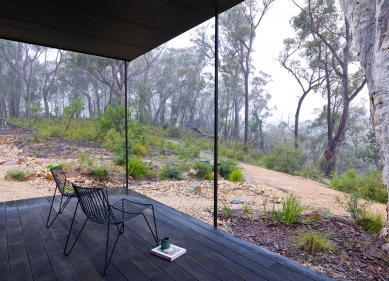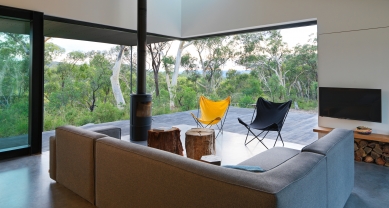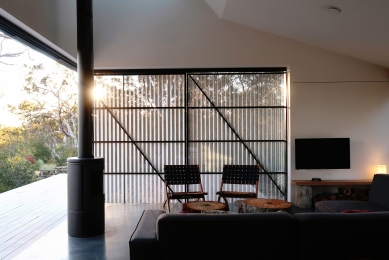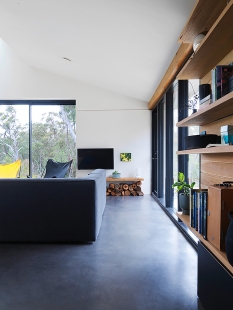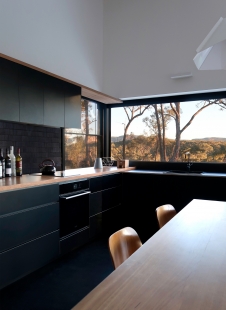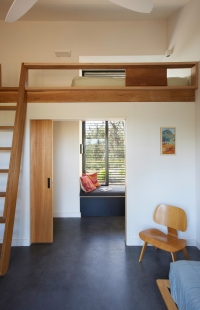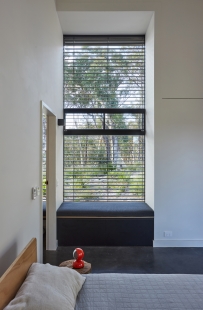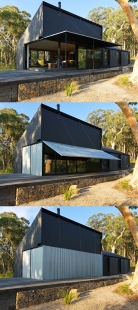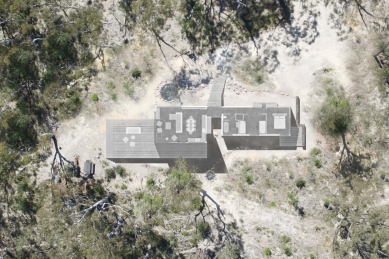
Off Grid House

Nestled in Sydney’s dense Blue Mountains bushland, Off Grid House acts as a premium benchmark for sustainable living under extreme conditions while coexisting with nature. The modest, highly durable home is net zero emissions and BAL-FZ rated; self-sufficient in power, water and sewage. The distinctive architectural form is a contemporary twist on the typical elongated passive-designed dwelling, unifying two skillion roofs of opposing slopes to optimise solar energy generation for electricity as well as passive heating and cooling for thermal comfort, bolstered by high levels of insulation and air tightness, an HRV, external shading and double glazing. Trees cleared to adhere to bushfire safety requirements are reused within the home, showcased most noticeably through joinery. This environmentally and ecologically considerate design celebrates Australia’s great outdoors, providing an oasis connected to nature as well as a safe haven when protection is required; testament to sensitive, innovative and sustainable architectural practices.
What was the brief?
The brief was to design a bushfire resilient, net zero emissions home, with minimal carbon emissions produced during construction. With no access to services and treetop views across the valley, the 3.2-hectare block was a prime site upon which to create an off-grid home.
What were the key challenges?
The primary challenge - and appeal - of the project was the remote location engulfed by dense bushland. The site was deemed BAL-FZ (Flame Zone), which is the highest rating of bushfire risk in Australia, and with lacking access to services, safety and technology were crucial. Additionally, paramount to Anderson Architecture’s practice is providing sustainable architecture, from procurement through to post occupancy. As such, the main challenges were linked to balancing the design objectives with the stringent building codes to ensure a low cost, bushfire-resistant home, which retained as much of the surrounding bushland as possible.
What were the solutions?
The result was the creation of a modest yet highly durable home, designed to withstand extreme conditions and the test of time. Off Grid House was constructed with minimal embodied energy and continues to require zero operational carbon emissions. Inspired by the local sandstone caves, the home fosters a connection with nature and also closes up when outside conditions are unfavourable, offering prospect and refuge. Being perched on a ridge, Off Grid House boasts views across the valley, extended through the deck wrapping around the southern wing.
The site was a primary driver determining the construction methods and material palette for Off Grid House. A concrete shell was utilised to provide the home’s fireproof skeleton, with a low carbon magnesium oxide cladding providing a flameproof skin, embracing the insulation between. As an additional fire-proofing measure, the verandah roof affords a dual purpose, folding down to be used as a flame zone bushfire screen as required. The trees which required removal to meet safety regulations were recycled and reused on site within the internal structure and joinery, displaying a variety of textures, colours and maturity.
Off Grid House is completely self-sufficient. Rainwater collected from roofing serves all the home’s needs and a worm farm wastewater treatment system manages sewerage. Large double-glazed windows and doors frame vignettes of the landscape, while assisting the optimisation of the thermal capabilities offered by the concrete flooring. The low carbon emissions produced during construction were offset with carbon credits.
What started as somewhat of an experiment has encouraged a brilliant learning curve to occur within the practice, as Anderson Architecture now specialises in designing sustainable homes in extreme conditions as well as in the inner city.
What was the brief?
The brief was to design a bushfire resilient, net zero emissions home, with minimal carbon emissions produced during construction. With no access to services and treetop views across the valley, the 3.2-hectare block was a prime site upon which to create an off-grid home.
What were the key challenges?
The primary challenge - and appeal - of the project was the remote location engulfed by dense bushland. The site was deemed BAL-FZ (Flame Zone), which is the highest rating of bushfire risk in Australia, and with lacking access to services, safety and technology were crucial. Additionally, paramount to Anderson Architecture’s practice is providing sustainable architecture, from procurement through to post occupancy. As such, the main challenges were linked to balancing the design objectives with the stringent building codes to ensure a low cost, bushfire-resistant home, which retained as much of the surrounding bushland as possible.
What were the solutions?
The result was the creation of a modest yet highly durable home, designed to withstand extreme conditions and the test of time. Off Grid House was constructed with minimal embodied energy and continues to require zero operational carbon emissions. Inspired by the local sandstone caves, the home fosters a connection with nature and also closes up when outside conditions are unfavourable, offering prospect and refuge. Being perched on a ridge, Off Grid House boasts views across the valley, extended through the deck wrapping around the southern wing.
The site was a primary driver determining the construction methods and material palette for Off Grid House. A concrete shell was utilised to provide the home’s fireproof skeleton, with a low carbon magnesium oxide cladding providing a flameproof skin, embracing the insulation between. As an additional fire-proofing measure, the verandah roof affords a dual purpose, folding down to be used as a flame zone bushfire screen as required. The trees which required removal to meet safety regulations were recycled and reused on site within the internal structure and joinery, displaying a variety of textures, colours and maturity.
Off Grid House is completely self-sufficient. Rainwater collected from roofing serves all the home’s needs and a worm farm wastewater treatment system manages sewerage. Large double-glazed windows and doors frame vignettes of the landscape, while assisting the optimisation of the thermal capabilities offered by the concrete flooring. The low carbon emissions produced during construction were offset with carbon credits.
What started as somewhat of an experiment has encouraged a brilliant learning curve to occur within the practice, as Anderson Architecture now specialises in designing sustainable homes in extreme conditions as well as in the inner city.
0 comments
add comment






